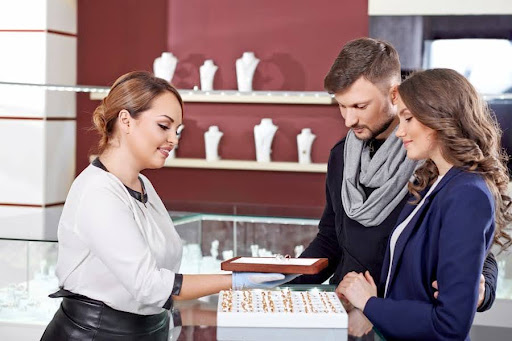Often necessitating the careful selection of jewellery to complement traditional dress, attending a cultural wedding is a vibrant and enlightening experience.
The right accessories elevate elegance while honouring cultural subtleties, whether it’s an Indian, Chinese, or Middle Eastern party. Matching jewellery with Asian wedding guest dresses is both intriguing and challenging for guests, as it requires balancing personal flair, tradition, and the solemnity of the event.
Every decision, from intricate gold pieces to fine gems, embodies aesthetic harmony and cultural value. This handbook examines key aspects to consider so that your jewellery not only enhances your style but also respects the history of the event.
Grasp the Cultural Value
Deep symbolic significance is frequently attached to jewellery in traditional marriages. Indian weddings, for example, often highlight gold as a symbol of wealth; Chinese rituals, on the other hand, stress jade as a symbol of luck and protection.
To avoid unsuitable decisions, study the customs connected with the occasion. If you are invited to a South Asian wedding, Kundan or Polki sets beautifully enhance traditional attire. Middle Eastern celebrations also could demand strong statement pieces.
Knowing these subtleties helps you match your accessories to the cultural context and display respect, while also enhancing your outfit. Always prioritise honesty; where appropriate, opt for classical styles over contemporary interpretations.
Align Jewellery with Style and Clothing Colour
Matching jewellery with your clothes is quite important. Choose jewellery that complements rather than overpowers for richly embroidered clothing like a lehenga or saree. Choose plainer items if your clothing has many adornments. On the other hand, a minimalist outfit allows for bolder accessories.
Consider gemstone colours; emeralds complement green clothing beautifully with gold, while rubies enhance warm red outfits. Pay attention to necklines; high necklines pair well with chokers, while deep V-necklines layered necklaces. The key is balance; either the clothing or the jewellery should take centre stage.
Give Comfort and Usefulness Priority
Although looks are important, comfort is just as so. Long celebrations or lively receptions can make heavy jewellery difficult. Test worn products beforehand to make sure they don’t irritate your skin or restrict motion.
For outdoor weddings, avoid delicate fabrics that could tarnish in humidity. Select safe clasps to prevent loss, especially with heirloom items. Avoid excessively long earrings or jingling bracelets if dance is required. The aim is to look great while celebrating without frequent changes.
Integrate Modern and Ancient Components
Combining traditional and contemporary looks produces a distinctive appearance. Match temple jewellery with a minimalist dress or combine a traditional jadau necklace with a contemporary cocktail ring.
This method is especially suited for multicultural attendees or fusion weddings. Still, be culturally aware and avoid using symbols or motifs from various civilisations. Subtle fusion, such as a basic choker with ethnic pattern,,s strikes the ideal equilibrium between personal style and legacy.
Watch Metals and Materials
Some civilisations connect particular metals with ceremonies. While silver plays a major role in tribal rituals, gold is considered highly auspicious in Hindu marriages. When attending such events, ensure your choices reflect these traditions skip white gold and opt for classic yellow gold instead. If you’re searching for Indian wedding dresses in Bradford, explore collections that not only honour cultural customs but also offer beautifully crafted outfits.
Many stores sell elegant bridal and guest dresses made with traditional fabrics and embellishments. For eco-conscious buyers, upcycled or ethically sourced materials are great options. Also, ensure any precious stones used are genuine, as synthetic ones might not suit sophisticated ceremonies.
Arrange Hairstyle and Makeup With One Another
Your jewellery should match your whole appearance. Updos showcase statement earrings; loose waves pair well with layered necklaces. Avoid clashes between strong makeup and elaborate jewellery.. When wearing a heavily embellished maang tikka, opt for neutral eye makeup. Men might consider cufflinks or brooches that complement their sherwani or suit. The goal is a unified look where each component complements the others.
Respect Religious and Cultural Etiquette
Certain traditions have rigid jewellery guidelines. In Muslim weddings, refrain from over-accessorising during religious ceremonies. Sikh weddings often involve head coverings, which can impact earring wear. Be conservative and minimalist if uncertain. Consult or inquire discreetly to prevent unintentional offence, for example, wearing toe rings might be improper unless married in some cultures.
Conclusion
Selecting jewellery for cultural weddings is an issue of research, imagination, and sensitivity. If you appreciate traditions, harmonise with your attire, and consider comfort, you can select items that respect the occasion without forsaking who you are.
Whether at an expansive Indian wedding or a low-key Chinese ceremony, the right accessories will make you a vision of loveliness and cultural consciousness. Let your jewellery be a storybook tale, one of respect for heritage and celebration of love.

